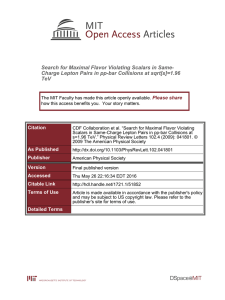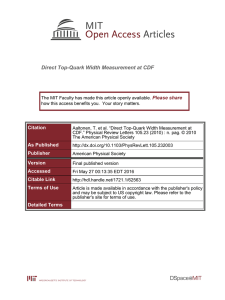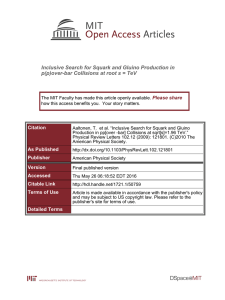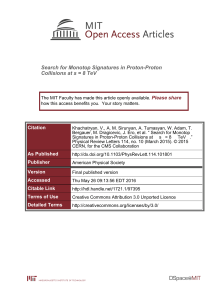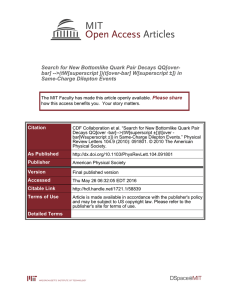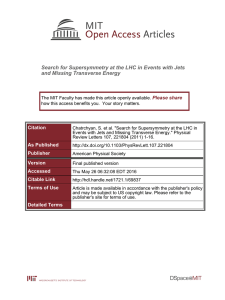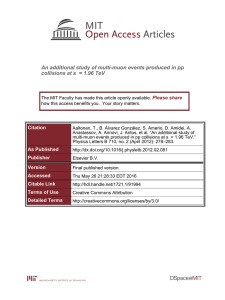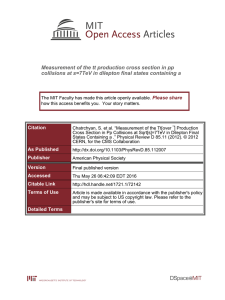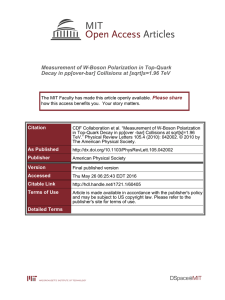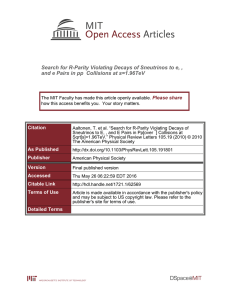Search for Heavy Bottomlike Quarks Decaying to an
advertisement
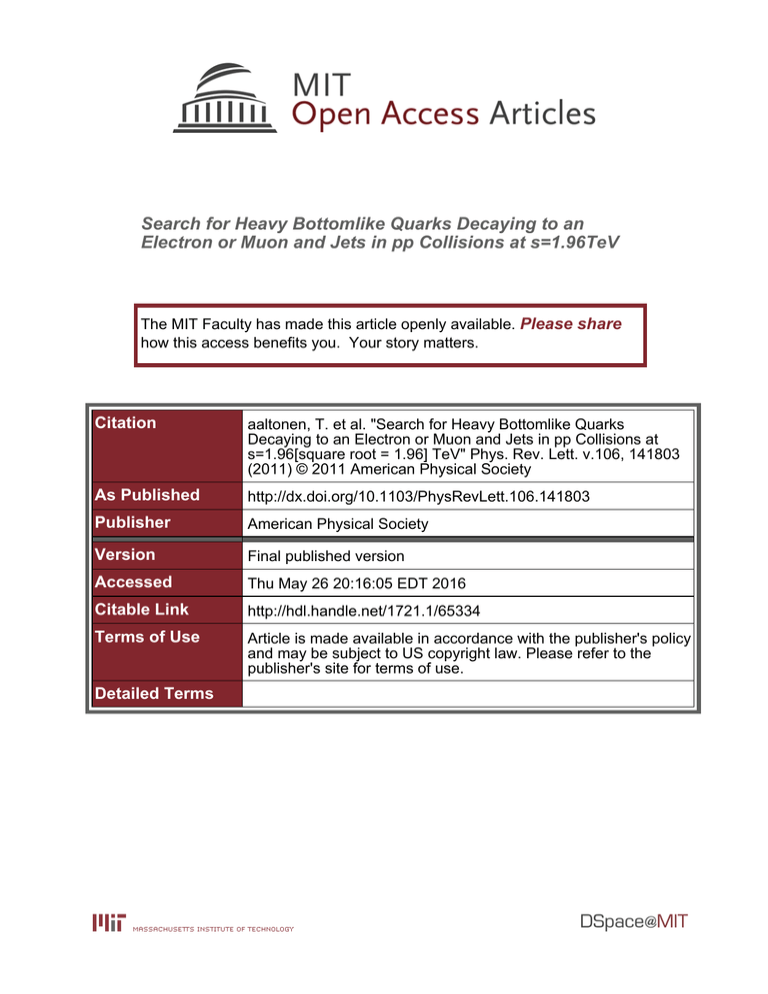
Search for Heavy Bottomlike Quarks Decaying to an Electron or Muon and Jets in pp Collisions at s=1.96TeV The MIT Faculty has made this article openly available. Please share how this access benefits you. Your story matters. Citation aaltonen, T. et al. "Search for Heavy Bottomlike Quarks Decaying to an Electron or Muon and Jets in pp Collisions at s=1.96[square root = 1.96] TeV" Phys. Rev. Lett. v.106, 141803 (2011) © 2011 American Physical Society As Published http://dx.doi.org/10.1103/PhysRevLett.106.141803 Publisher American Physical Society Version Final published version Accessed Thu May 26 20:16:05 EDT 2016 Citable Link http://hdl.handle.net/1721.1/65334 Terms of Use Article is made available in accordance with the publisher's policy and may be subject to US copyright law. Please refer to the publisher's site for terms of use. Detailed Terms PRL 106, 141803 (2011) week ending 8 APRIL 2011 PHYSICAL REVIEW LETTERS Search for Heavy Bottomlike Quarks Decaying pffiffiffi to an Electron or Muon and Jets in pp Collisions at s ¼ 1:96 TeV T. Aaltonen,22 B. Álvarez González,10,w S. Amerio,42a D. Amidei,33 A. Anastassov,37 A. Annovi,18 J. Antos,13 G. Apollinari,16 J. A. Appel,16 A. Apresyan,47 T. Arisawa,57 A. Artikov,14 J. Asaadi,52 W. Ashmanskas,16 B. Auerbach,60 A. Aurisano,52 F. Azfar,41 W. Badgett,16 A. Barbaro-Galtieri,27 V. E. Barnes,47 B. A. Barnett,24 P. Barria,45c,45a P. Bartos,13 M. Bauce,42b,42a G. Bauer,31 F. Bedeschi,45a D. Beecher,29 S. Behari,24 G. Bellettini,45b,45a J. Bellinger,59 D. Benjamin,15 A. Beretvas,16 A. Bhatti,1 M. Binkley,16,a D. Bisello,42b,42a I. Bizjak,29,aa K. R. Bland,5 B. Blumenfeld,24 A. Bocci,15 A. Bodek,48 D. Bortoletto,47 J. Boudreau,46 A. Boveia,12 B. Brau,16,b L. Brigliadori,6b,6a A. Brisuda,13 C. Bromberg,34 E. Brucken,22 M. Bucciantonio,45b,45a J. Budagov,14 H. S. Budd,48 S. Budd,23 K. Burkett,16 G. Busetto,42b,42a P. Bussey,20 A. Buzatu,32 C. Calancha,30 S. Camarda,4 M. Campanelli,34 M. Campbell,33 F. Canelli,12,16 A. Canepa,44 B. Carls,23 D. Carlsmith,59 R. Carosi,45a S. Carrillo,17,l S. Carron,16 B. Casal,10 M. Casarsa,16 A. Castro,6b,6a P. Catastini,16 D. Cauz,53a V. Cavaliere,45c,45a M. Cavalli-Sforza,4 A. Cerri,27,g L. Cerrito,29,r Y. C. Chen,1 M. Chertok,7 G. Chiarelli,45a G. Chlachidze,16 F. Chlebana,16 K. Cho,26 D. Chokheli,14 J. P. Chou,21 W. H. Chung,59 Y. S. Chung,48 C. I. Ciobanu,43 M. A. Ciocci,45c,45a A. Clark,19 G. Compostella,42b,42a M. E. Convery,16 J. Conway,7 M. Corbo,43 M. Cordelli,18 C. A. Cox,7 D. J. Cox,7 F. Crescioli,45b,45a C. Cuenca Almenar,60 J. Cuevas,10,w R. Culbertson,16 D. Dagenhart,16 N. d’Ascenzo,43,u M. Datta,16 P. de Barbaro,48 S. De Cecco,50a G. De Lorenzo,4 M. Dell’Orso,45b,45a C. Deluca,4 L. Demortier,1 J. Deng,15,d M. Deninno,6a F. Devoto,22 M. d’Errico,42b,42a A. Di Canto,45b,45a B. Di Ruzza,45a J. R. Dittmann,5 M. D’Onofrio,28 S. Donati,45b,45a P. Dong,16 M. Dorigo,53a T. Dorigo,42a K. Ebina,57 A. Elagin,52 A. Eppig,33 R. Erbacher,7 D. Errede,23 S. Errede,23 N. Ershaidat,43,z R. Eusebi,52 H. C. Fang,27 S. Farrington,41 M. Feindt,25 J. P. Fernandez,30 C. Ferrazza,45d,45a R. Field,17 G. Flanagan,47,s R. Forrest,7 M. J. Frank,5 M. Franklin,21 J. C. Freeman,16 Y. Funakoshi,57 I. Furic,17 M. Gallinaro,1 J. Galyardt,11 J. E. Garcia,19 A. F. Garfinkel,47 P. Garosi,45c,45a H. Gerberich,23 E. Gerchtein,16 S. Giagu,50b,50a V. Giakoumopoulou,3 P. Giannetti,45a K. Gibson,46 C. M. Ginsburg,16 N. Giokaris,3 P. Giromini,18 M. Giunta,45a G. Giurgiu,24 V. Glagolev,14 D. Glenzinski,16 M. Gold,36 D. Goldin,52 N. Goldschmidt,17 A. Golossanov,16 G. Gomez,10 G. Gomez-Ceballos,31 M. Goncharov,31 O. González,30 I. Gorelov,36 A. T. Goshaw,15 K. Goulianos,1 A. Gresele,42a S. Grinstein,4 C. Grosso-Pilcher,12 R. C. Group,56 J. Guimaraes da Costa,21 Z. Gunay-Unalan,34 C. Haber,27 S. R. Hahn,16 E. Halkiadakis,51 A. Hamaguchi,40 J. Y. Han,48 F. Happacher,18 K. Hara,54 D. Hare,51 M. Hare,55 R. F. Harr,58 K. Hatakeyama,5 C. Hays,41 M. Heck,25 J. Heinrich,44 M. Herndon,59 S. Hewamanage,5 D. Hidas,51 A. Hocker,16 W. Hopkins,16,h D. Horn,25 S. Hou,1 R. E. Hughes,38 M. Hurwitz,12 U. Husemann,60 N. Hussain,32 M. Hussein,34 J. Huston,34 G. Introzzi,45a M. Iori,50b,50a A. Ivanov,7,p E. James,16 D. Jang,11 B. Jayatilaka,15 E. J. Jeon,26 M. K. Jha,6a S. Jindariani,16 W. Johnson,7 M. Jones,47 K. K. Joo,26 S. Y. Jun,11 T. R. Junk,16 T. Kamon,52 P. E. Karchin,58 Y. Kato,40,o W. Ketchum,12 J. Keung,44 V. Khotilovich,52 B. Kilminster,16 D. H. Kim,26 H. S. Kim,26 H. W. Kim,26 J. E. Kim,26 M. J. Kim,18 S. B. Kim,26 S. H. Kim,54 Y. K. Kim,12 N. Kimura,57 M. Kirby,16 S. Klimenko,17 K. Kondo,57 D. J. Kong,26 J. Konigsberg,17 A. V. Kotwal,15 M. Kreps,25 J. Kroll,44 D. Krop,12 N. Krumnack,5,m M. Kruse,15 V. Krutelyov,52,e T. Kuhr,25 M. Kurata,54 S. Kwang,12 A. T. Laasanen,47 S. Lami,45a S. Lammel,16 M. Lancaster,29 R. L. Lander,7 K. Lannon,38,v A. Lath,51 G. Latino,45c,45a I. Lazzizzera,42a T. LeCompte,2 E. Lee,52 H. S. Lee,12 J. S. Lee,26 S. W. Lee,52,x S. Leo,45b,45a S. Leone,45a J. D. Lewis,16 C.-J. Lin,27 J. Linacre,41 M. Lindgren,16 E. Lipeles,44 A. Lister,19 D. O. Litvintsev,16 C. Liu,46 Q. Liu,47 T. Liu,16 S. Lockwitz,60 N. S. Lockyer,44 A. Loginov,60 D. Lucchesi,42b,42a J. Lueck,25 P. Lujan,27 P. Lukens,16 G. Lungu,1 J. Lys,27 R. Lysak,13 R. Madrak,16 K. Maeshima,16 K. Makhoul,31 P. Maksimovic,24 S. Malik,1 G. Manca,28,c A. Manousakis-Katsikakis,3 F. Margaroli,47 C. Marino,25 M. Martı́nez,4 R. Martı́nez-Balları́n,30 P. Mastrandrea,50a M. Mathis,24 M. E. Mattson,58 P. Mazzanti,6a K. S. McFarland,48 P. McIntyre,52 R. McNulty,28,j A. Mehta,28 P. Mehtala,22 A. Menzione,45a C. Mesropian,1 T. Miao,16 D. Mietlicki,33 A. Mitra,1 H. Miyake,54 S. Moed,21 N. Moggi,6a M. N. Mondragon,16,l C. S. Moon,26 R. Moore,16 M. J. Morello,16 J. Morlock,25 P. Movilla Fernandez,16 A. Mukherjee,16 Th. Muller,25 P. Murat,16 M. Mussini,6b,6a J. Nachtman,16,n Y. Nagai,54 J. Naganoma,57 I. Nakano,39 A. Napier,55 J. Nett,52 C. Neu,56 M. S. Neubauer,23 J. Nielsen,27,f L. Nodulman,2 O. Norniella,23 E. Nurse,29 L. Oakes,41 S. H. Oh,15 Y. D. Oh,26 I. Oksuzian,56 T. Okusawa,40 R. Orava,22 L. Ortolan,4 S. Pagan Griso,42b,42a C. Pagliarone,53a E. Palencia,10,g V. Papadimitriou,16 A. A. Paramonov,2 J. Patrick,16 G. Pauletta,53b,53a M. Paulini,11 C. Paus,31 D. E. Pellett,7 A. Penzo,53a T. J. Phillips,15 G. Piacentino,45a E. Pianori,44 J. Pilot,38 K. Pitts,23 C. Plager,9 L. Pondrom,59 K. Potamianos,47 O. Poukhov,14,a F. Prokoshin,14,y A. Pronko,16 F. Ptohos,18,i E. Pueschel,11 G. Punzi,45b,45a J. Pursley,59 A. Rahaman,46 V. Ramakrishnan,59 N. Ranjan,47 I. Redondo,30 0031-9007=11=106(14)=141803(7) 141803-1 Ó 2011 American Physical Society PRL 106, 141803 (2011) PHYSICAL REVIEW LETTERS week ending 8 APRIL 2011 P. Renton,41 M. Rescigno,50a F. Rimondi,6b,6a L. Ristori,45a,16 A. Robson,20 T. Rodrigo,10 T. Rodriguez,44 E. Rogers,23 S. Rolli,55 R. Roser,16 M. Rossi,53a F. Rubbo,16 F. Ruffini,45c,45a A. Ruiz,10 J. Russ,11 V. Rusu,16 A. Safonov,52 W. K. Sakumoto,48 Y. Sakurai,57 L. Santi,53b,53a L. Sartori,45a K. Sato,54 V. Saveliev,43,u A. Savoy-Navarro,43 P. Schlabach,16 A. Schmidt,25 E. E. Schmidt,16 M. P. Schmidt,60,a M. Schmitt,37 T. Schwarz,7 L. Scodellaro,10 A. Scribano,45c,45a F. Scuri,45a A. Sedov,47 S. Seidel,36 Y. Seiya,40 A. Semenov,14 F. Sforza,45b,45a,aa A. Sfyrla,23 S. Z. Shalhout,7 T. Shears,28 P. F. Shepard,46 M. Shimojima,54,t S. Shiraishi,12 M. Shochet,12 I. Shreyber,35 A. Simonenko,14 P. Sinervo,32 A. Sissakian,14,a K. Sliwa,55 J. R. Smith,7 F. D. Snider,16 A. Soha,16 S. Somalwar,51 V. Sorin,4 P. Squillacioti,16 M. Stancari,16 M. Stanitzki,60 R. St. Denis,20 B. Stelzer,32 O. Stelzer-Chilton,32 D. Stentz,37 J. Strologas,36 G. L. Strycker,33 Y. Sudo,54 A. Sukhanov,17 I. Suslov,14 K. Takemasa,54 Y. Takeuchi,54 J. Tang,12 M. Tecchio,33 P. K. Teng,1 J. Thom,16,h J. Thome,11 G. A. Thompson,23 E. Thomson,44 P. Ttito-Guzmán,30 S. Tkaczyk,16 D. Toback,52 S. Tokar,13 K. Tollefson,34 T. Tomura,54 D. Tonelli,16 S. Torre,18 D. Torretta,16 P. Totaro,53b,53a M. Trovato,45d,45a Y. Tu,44 F. Ukegawa,54 S. Uozumi,26 A. Varganov,33 F. Vázquez,17,l G. Velev,16 C. Vellidis,3 M. Vidal,30 I. Vila,10 R. Vilar,10 J. Vizán,10 M. Vogel,36 G. Volpi,45b,45a P. Wagner,44 R. L. Wagner,16 T. Wakisaka,40 R. Wallny,9 S. M. Wang,1 A. Warburton,32 D. Waters,29 M. Weinberger,52 W. C. Wester III,16 B. Whitehouse,55 D. Whiteson,8 A. B. Wicklund,2 E. Wicklund,16 S. Wilbur,12 F. Wick,25 H. H. Williams,44 J. S. Wilson,38 P. Wilson,16 B. L. Winer,38 P. Wittich,16,h S. Wolbers,16 H. Wolfe,38 T. Wright,33 X. Wu,19 Z. Wu,5 K. Yamamoto,40 J. Yamaoka,15 T. Yang,16 U. K. Yang,12,q Y. C. Yang,26 W.-M. Yao,27 G. P. Yeh,16 K. Yi,16,n J. Yoh,16 K. Yorita,57 T. Yoshida,40,k G. B. Yu,15 I. Yu,26 S. S. Yu,16 J. C. Yun,16 A. Zanetti,53a Y. Zeng,15 and S. Zucchelli6b,6a (CDF Collaboration) 1 Institute of Physics, Academia Sinica, Taipei, Taiwan 11529, Republic of China 2 Argonne National Laboratory, Argonne, Illinois 60439, USA 3 University of Athens, 157 71 Athens, Greece 4 Institut de Fisica d’Altes Energies, ICREA, Universitat Autonoma de Barcelona, E-08193, Bellaterra (Barcelona), Spain 5 Baylor University, Waco, Texas 76798, USA 6a Istituto Nazionale di Fisica Nucleare Bologna, I-40127 Bologna, Italy 6b University of Bologna, I-40127 Bologna, Italy 7 University of California, Davis, Davis, California 95616, USA 8 University of California, Irvine, Irvine, California 92697, USA 9 University of California, Los Angeles, Los Angeles, California 90024, USA 10 Instituto de Fisica de Cantabria, CSIC-University of Cantabria, 39005 Santander, Spain 11 Carnegie Mellon University, Pittsburgh, Pennsylvania 15213, USA 12 Enrico Fermi Institute, University of Chicago, Chicago, Illinois 60637, USA 13 Comenius University, 842 48 Bratislava, Slovakia; Institute of Experimental Physics, 040 01 Kosice, Slovakia 14 Joint Institute for Nuclear Research, RU-141980 Dubna, Russia 15 Duke University, Durham, North Carolina 27708, USA 16 Fermi National Accelerator Laboratory, Batavia, Illinois 60510, USA 17 University of Florida, Gainesville, Florida 32611, USA 18 Laboratori Nazionali di Frascati, Istituto Nazionale di Fisica Nucleare, I-00044 Frascati, Italy 19 University of Geneva, CH-1211 Geneva 4, Switzerland 20 Glasgow University, Glasgow G12 8QQ, United Kingdom 21 Harvard University, Cambridge, Massachusetts 02138, USA 22 Division of High Energy Physics, Department of Physics, University of Helsinki and Helsinki Institute of Physics, FIN-00014, Helsinki, Finland 23 University of Illinois, Urbana, Illinois 61801, USA 24 The Johns Hopkins University, Baltimore, Maryland 21218, USA 25 Institut für Experimentelle Kernphysik, Karlsruhe Institute of Technology, D-76131 Karlsruhe, Germany 26 Center for High Energy Physics: Kyungpook National University, Daegu 702-701, Korea; Seoul National University, Seoul 151-742, Korea; Sungkyunkwan University, Suwon 440-746, Korea; Korea Institute of Science and Technology Information, Daejeon 305-806, Korea; Chonnam National University, Gwangju 500-757, Korea; Chonbuk National University, Jeonju 561-756, Korea 27 Ernest Orlando Lawrence Berkeley National Laboratory, Berkeley, California 94720, USA 28 University of Liverpool, Liverpool L69 7ZE, United Kingdom 29 University College London, London WC1E 6BT, United Kingdom 30 Centro de Investigaciones Energeticas Medioambientales y Tecnologicas, E-28040 Madrid, Spain 31 Massachusetts Institute of Technology, Cambridge, Massachusetts 02139, USA 141803-2 PRL 106, 141803 (2011) PHYSICAL REVIEW LETTERS week ending 8 APRIL 2011 32 Institute of Particle Physics: McGill University, Montréal, Québec, Canada H3A 2T8; Simon Fraser University, Burnaby, British Columbia, Canada V5A 1S6; University of Toronto, Toronto, Ontario, Canada M5S 1A7; and TRIUMF, Vancouver, British Columbia, Canada V6T 2A3 33 University of Michigan, Ann Arbor, Michigan 48109, USA 34 Michigan State University, East Lansing, Michigan 48824, USA 35 Institution for Theoretical and Experimental Physics, ITEP, Moscow 117259, Russia 36 University of New Mexico, Albuquerque, New Mexico 87131, USA 37 Northwestern University, Evanston, Illinois 60208, USA 38 The Ohio State University, Columbus, Ohio 43210, USA 39 Okayama University, Okayama 700-8530, Japan 40 Osaka City University, Osaka 588, Japan 41 University of Oxford, Oxford OX1 3RH, United Kingdom 42a Istituto Nazionale di Fisica Nucleare, Sezione di Padova-Trento, I-35131 Padova, Italy 42b University of Padova, I-35131 Padova, Italy 43 LPNHE, Universite Pierre et Marie Curie/IN2P3-CNRS, UMR7585, Paris, F-75252 France 44 University of Pennsylvania, Philadelphia, Pennsylvania 19104, USA 45a Istituto Nazionale di Fisica Nucleare Pisa, I-56127 Pisa, Italy 45b University of Pisa, I-56127 Pisa, Italy 45c University of Siena, I-56127 Pisa, Italy 45d Scuola Normale Superiore, I-56127 Pisa, Italy 46 University of Pittsburgh, Pittsburgh, Pennsylvania 15260, USA 47 Purdue University, West Lafayette, Indiana 47907, USA 48 University of Rochester, Rochester, New York 14627, USA 1 The Rockefeller University, New York, New York 10065, USA 50a Istituto Nazionale di Fisica Nucleare, Sezione di Roma 1, I-00185 Roma, Italy 50b Sapienza Università di Roma, I-00185 Roma, Italy 51 Rutgers University, Piscataway, New Jersey 08855, USA 52 Texas A&M University, College Station, Texas 77843, USA 53a Istituto Nazionale di Fisica Nucleare Trieste/Udine, I-34100 Trieste, Italy 53b University of Trieste/Udine, I-33100 Udine, Italy 54 University of Tsukuba, Tsukuba, Ibaraki 305, Japan 55 Tufts University, Medford, Massachusetts 02155, USA 56 University of Virginia, Charlottesville, Virginia 22906, USA 57 Waseda University, Tokyo 169, Japan 58 Wayne State University, Detroit, Michigan 48201, USA 59 University of Wisconsin, Madison, Wisconsin 53706, USA 60 Yale University, New Haven, Connecticut 06520, USA (Received 29 January 2011; published 6 April 2011) We report the most sensitive direct search for pair production of fourth-generation bottomlike chiral quarks (b0 ) each decaying promptly to tW. We search for an excess of events with an electron or muon, at least five jets (one identified as due to a b or c quark), and an imbalance of transverse momentum by using data from pp collisions collected by the CDF II detector at Fermilab with an integrated luminosity of 4:8 fb1 . We observe events consistent with background expectation, calculate upper limits on the b0 pairproduction cross section (bb0 & 30 fb for mb0 > 375 GeV=c2 ), and exclude mb0 < 372 GeV=c2 at 95% confidence level assuming a 100% branching ratio of b0 to tW. DOI: 10.1103/PhysRevLett.106.141803 PACS numbers: 14.65.Jk, 12.60.i, 13.85.Rm, 14.80.j The standard model of particle physics accommodates three generations of fundamental fermions but is agnostic on the issue of a fourth generation. Precision measurements in the electroweak sector are not inconsistent with a fourth generation of fermions if there is a 50–100 GeV=c2 splitting in the quark and lepton masses [1]. A four-generation model [2] could provide a source of particle-antiparticle asymmetry large enough to account for the baryon asymmetry of the Universe [3] and accommodate a heavier Higgs boson (the source of mass generation) than a three-generation model [4]. Direct searches for production of chiral fourth-generation quarks restrict their masses to be greater than 335 GeV=c2 [5] for an up-type quark t0 decaying via t0 ! Wq and 338 GeV=c2 [6] for a down-type quark b0 decaying via b0 ! tW. This Letter reports a search for pair production via strong interactions of a heavy chiral [7] bottomlike quark b0 followed by prompt decay to a t quark and a W boson 141803-3 PRL 106, 141803 (2011) PHYSICAL REVIEW LETTERS with branching ratio Bðb0 ! WtÞ ¼ 100%. The assumption that b0 decays exclusively to tW is reasonable if the coupling to light quarks is small, as expected from precision meson-mixing measurements [8], and in the hypothesis that mb0 > mt þ mW . In the case that the branching fraction deviates from 100%, the limits can be interpreted under different assumptions [9]. Previous searches considered the mode in which two same-charge W bosons decayed leptonically [6], which gives a low-background signature but a low selection efficiency due to the small W ! ‘ branching ratio. We consider the mode b0 b0 ! W þ tW t ! W þ W bW þ W b ! ‘qq0 bqq0 qq0 b in which one W boson decays leptonically (including decays to e or ) and the remaining three W bosons decay hadronically, giving a selection efficiency nearly 4 times the previous search. The larger standard model backgrounds can be separated from a potential signal by comparing the total reconstructed transverse momentum in the event. Events were recorded by CDF II [10,11], a general purpose detector designed to study pffiffiffi collisions at the Fermilab Tevatron pp collider at s ¼ 1:96 TeV. A chargedparticle tracking system immersed in a 1.4 T magnetic field consists of a silicon microstrip tracker and a drift chamber. Electromagnetic and hadronic calorimeters surround the tracking system and measure particle energies. Drift chambers located outside the calorimeters detect muons. We use a data sample corresponding to an integrated luminosity of 4:8 0:3 fb1 . The data acquisition system is triggered by e or candidates [12] with transverse momentum pT [11] greater than 18 GeV=c. Electrons and muons are reconstructed off-line and selected if they have absolute value of pseudorapidity [11] less than 1.1, pT 20 GeV=c, and satisfy the standard CDF identification and isolation requirements [12]. Jets are reconstructed in the calorimeter by using the JETCLU [13] algorithm with a clustering radius of 0.4 in azimuth-pseudorapidity space and corrected by using the standard techniques [14]. Jets are selected if they have pT 15 GeV=c and jj < 2:4. Each jet is considered for heavy-flavor tagging by using the default CDF b-jet identification algorithm (SECVTX [15]) that searches in the jet for a secondary vertex which results from the displaced decay of a B hadron inside the jet. Missing transverse momentum [16] is reconstructed by using fully corrected calorimeter and muon information [12]. Production and decay of b0 pairs would appear as events with a charged lepton and missing transverse momentum from the leptonically decaying W and a large number of jets from the two b quarks and the hadronic decays of the other three W bosons. We select events with exactly one electron or muon, at least five jets, and at least 20 GeV=c of missing transverse momentum. At least one of the jets must be identified as due to b quark decay. We find 357 events satisfying these requirements. week ending 8 APRIL 2011 We model the production and decay of b0 pairs with MADGRAPH [17]. Additional radiation, hadronization, and showering are provided by PYTHIA [18]. The detector response for all simulated samples is modeled by CDFSIM [19]. The signal efficiency for the above requirements is approximately 9%, rising with b0 mass. There are eight quarks produced in the decay, but the most likely number of reconstructed jets is six, as quarks that are close together are likely to be merged into a single jet, and some of the quarks produce jets which fall below the transverse momentum threshold. Complete mass reconstruction is therefore not possible in the majority of the events; instead, we examine the event ST , the scalar sum of the transverse momentum of the lepton, jets, and missing transverse momentum. This is well correlated with the mass of the heavy quark and serves as an approximate mass reconstruction. The dominant background (80%) is top-quark pair production with additional jets from initial or final state radiation. This background can be distinguished from the signal as it has smaller ST . We model this background by using MADGRAPH tt production with mt ¼ 172:5 GeV=c2 in which radiation of up to three additional hard partons (including heavy flavor) are described explicitly by using matrix elements, and additional radiation is described by the parton shower; the MLM [20] scheme is used to match the matrix-element and parton-shower contributions. This gives a precise description of events with 7 jets, where a b0 signal would be expected. Events with eight jets and above are described by the parton shower, which has significantly larger systematic uncertainties. We normalize the tt background to the next-to-leading-order (NLO) cross section [21] and confirm that it is well modeled by examining tt-dominated regions in the data. The second dominant background process ( 10%) is the associated production of W boson and jets. Samples of simulated W þ jets events with light- and heavy-flavor jets are generated by using the ALPGEN [22] program, interfaced with the parton-shower model from PYTHIA. The W þ jets samples are normalized to the measured W cross section, with an additional multiplicative factor for the relative contribution of heavy- and light-flavor jets, the standard technique in measuring the top-quark pairproduction cross section [15]. A multijet background ( 5%), in which a jet is misreconstructed as a lepton, is modeled by using a jet-triggered sample normalized in a background-dominated region at low missing transverse momentum. The remaining backgrounds, single top and diboson production, are modeled by using PYTHIA and normalized to next-to-leading order cross sections [23]. The combined background expectation is 365 194 events, including systematic and statistical uncertainties. A b0 signal would be readily separated from the background in both the number of jets and the ST . To take advantage of both of these characteristics, we introduce a 141803-4 N Events variable ST jet which equals ST for events with exactly 5 jets, N ST jet ¼ ST þ 1000 GeV for events with exactly 6 jets, and N ST jet ¼ ST þ 2000 GeV for events with at least 7 jets. This is equivalent to a two-dimensional analysis in Njets and ST . Figure 1 shows the distributions of an example b0 signal with mb0 ¼ 350 GeV=c2 and the backgrounds in jet multiN plicity and ST jet , as well as the expected backgrounds and observed data. We consider several sources of systematic uncertainty on both the background rates and distributions, as well as on the expectations for the signal. The dominant systematic uncertainties are the jet energy scale [14], contributions from multiple interaction in the same bunch crossing, and descriptions of initial and final state radiation [24]. The Data 100 Bkg. + b’ Total Bkg. 10 tt W,Z,t QCD 1 Events Obs. - Exp. Di-boson 10 Data Bkg Unc. b’ 0 -10 5 6 7 8 9 Number of Jets 10 100 Data Bkg. + b’ Total Bkg. 10 tt W,Z,t 1 QCD Obs. - Exp. Di-boson 10 0 -10 TABLE I. Expected and observed events in a backgrounddominated control region (ST < 400, 450, and 500 for Njet ¼ 5, 6, and 7, respectively) and in a signal-dominated region (ST > 400, 450, and 500 for Njet ¼ 5, 6, and 7, respectively) for our selection (see the text). Uncertainties are statistical and systematic, combined in quadrature. Jets 5 6 7 Control region Exp. Obs. 207 125 43 31 11 3:9 199 40 5 Signal region Exp. Obs. 84 65 18 12 3:4 3:4 87 14 12 Sum Exp. Obs. 291 190 61 43 14 7:1 286 54 17 impact on the cross-section upper limits of the uncertainty due to each source was estimated by varying it according to the amount of its uncertainty and observing the resulting N effects on the ST jet spectrum. Each uncertainty weakens the expected 95% confidence level (C.L.) cross-section upper limit by 60% individually. Additional uncertainty comes from parton distribution functions [25,26], the matching scale used between the matrix element and the parton shower, overall background normalization, and uncertainties in performance of the b-quark identification algorithm. The overall impact on the expected sensitivity is 100% in the cross section and 20 GeV=c2 on the expected mass limit. To validate the description of the backgrounds, we verify that the low ST region is well-described where there is little signal expected. See Table I. In events with 7 jets, the observed ST is larger than predicted by our background model. The number of observed events with 7 jets and ST > 500 GeV is 12 where we expect 3:4 3:4. However, the total number of events observed in the low ST and high ST regions combined is consistent with expectation. Considering only the number of events in the high ST regions and taking into account the systematic uncertainties in the background prediction, we see a more significant excess than that observed in the data in 12% of simulated experiments. N The full ST jet spectrum is used in the analysis. Since there is no evidence for the presence of b0 events in the data, we calculate 95% C.L. upper limits on the b0 TABLE II. Theoretical cross sections (NLO in fb [21,29]), selection efficiency , expected b0 yield (Nexp ) after selection, median expected 95% C.L. limit (exp in fb), and observed 95% C.L. limit (obs in fb) for b0 at varying masses. NLO and Nexp have 10% uncertainties. Data Uncert. b’ 0 week ending 8 APRIL 2011 PHYSICAL REVIEW LETTERS PRL 106, 141803 (2011) 500 1000 1500 2000 2500 3000 Njet ST N FIG. 1 (color online). Distributions in jet multiplicity and ST jet (defined in the text). The example b0 signal has mb0 ¼ 350 GeV=c2 and would have 29 4:5 events expected in this sample. The top panel is log scale; the bottom panel shows the difference between expected and observed events on a linear scale, as well as the total uncertainty on the expected events. The background uncertainty (Bkg Unc.) is shown as a solid gray line. Mass ½GeV=c2 NLO ð%Þ Nexp exp obs 141803-5 260 300 325 630 227 125 7 8 9 203.2 91.5 53.0 72 49 40 72 72 66 350 375 400 425 34 19 65 9.5 9 9 9 9 28.1 14.9 7.6 4.0 34 34 34 34 36 33 53 34 PHYSICAL REVIEW LETTERS PRL 106, 141803 (2011) Republic of China; the Swiss National Science Foundation; the A. P. Sloan Foundation; the Bundesministerium für Bildung und Forschung, Germany; the World Class University Program, the National Research Foundation of Korea; the Science and Technology Facilities Council and the Royal Society, United Kingdom; the Institut National de Physique Nucleaire et Physique des Particules/CNRS; the Russian Foundation for Basic Research; the Ministerio de Ciencia e Innovación and Programa Consolider-Ingenio 2010, Spain; the Slovak R&D Agency; and the Academy of Finland. Median Cross section [fb] 68% 102 95% Theory Observed 30 300 350 week ending 8 APRIL 2011 400 Quark mass [GeV/c2] FIG. 2 (color online). Upper limits on b0 production cross section at 95% C.L. assuming Bðb0 ! WtÞ ¼ 100%. The solid black line is the median expected upper limit in simulated experiments without a b0 signal; green and yellow bands represent 68% and 95% of simulated experiments, respectively; the solid red line is the observed limit. The dashed black line is the NLO b0 production cross section [21,29]. production cross section, by performing a binned N maximum-likelihood fit in the ST jet variable and allowing for systematic and statistical fluctuations via template morphing [27]. We use the likelihood-ratio ordering prescription [28] to construct classical confidence intervals in the theoretical cross section by generating ensembles of simulated experiments that describe expected fluctuations of statistical and systematic uncertainties on both the signal and backgrounds. The observed limits are consistent with expectation in the background-only hypothesis and are given together with theoretical NLO cross sections [21,29] in Table II and shown in Fig. 2. We convert upper limits on the pair-production cross sections to lower limits on the fermion masses. The relative cross-section uncertainty of 10% due to scale and parton distribution function uncertainties translates into 3 GeV=c2 for the mass lower limits. In conclusion, we have searched for pair production of b0 quarks with subsequent decay to tW. Though there are events with larger ST than expected in the 7-jet event distribution in Fig. 1, we do not see evidence of a signal. We calculate upper limits on the b0 pair-production cross section (& 30 fb for mb0 > 375 GeV=c2 ) and set the most restrictive direct lower limit on the mass of a downtype fourth-generation quark, increasing the limit by 34 GeV=c2 beyond previous limits and significantly reducing the allowed mass range to mb0 372 GeV=c2 . We thank the Fermilab staff and the technical staffs of the participating institutions for their vital contributions. This work was supported by the U.S. Department of Energy and National Science Foundation; the Italian Istituto Nazionale di Fisica Nucleare; the Ministry of Education, Culture, Sports, Science and Technology of Japan; the Natural Sciences and Engineering Research Council of Canada; the National Science Council of the 141803-6 a Deceased. Visitor from University of Massachusetts Amherst, Amherst, MA 01003, USA. c Visitor from Istituto Nazionale di Fisica Nucleare, Sezione di Cagliari, 09042 Monserrato (Cagliari), Italy. d Visitor from University of California Irvine, Irvine, CA 92697, USA. e Visitor from University of California Santa Barbara, Santa Barbara, CA 93106, USA. f Visitor from University of California Santa Cruz, Santa Cruz, CA 95064, USA. g Visitor from CERN, CH-1211 Geneva, Switzerland. h Visitor from Cornell University, Ithaca, NY 14853, USA. i Visitor from University of Cyprus, Nicosia CY-1678, Cyprus. j Visitor from University College Dublin, Dublin 4, Ireland. k Visitor from University of Fukui, Fukui City, Fukui Prefecture, Japan 910-0017. l Visitor from Universidad Iberoamericana, Mexico D.F., Mexico. m Visitor from Iowa State University, Ames, IA 50011, USA. n Visitor from University of Iowa, Iowa City, IA 52242, USA. o Visitor from Kinki University, Higashi-Osaka City, Japan 577-8502. p Visitor from Kansas State University, Manhattan, KS 66506, USA. q Visitor from University of Manchester, Manchester M13 9PL, United Kingdom. r Visitor from Queen Mary, University of London, London, E1 4NS, United Kingdom. s Visitor from Muons, Inc., Batavia, IL 60510, USA. t Visitor from Nagasaki Institute of Applied Science, Nagasaki, Japan. u Visitor from National Research Nuclear University, Moscow, Russia. v Visitor from University of Notre Dame, Notre Dame, IN 46556, USA. w Visitor from Universidad de Oviedo, E-33007 Oviedo, Spain. x Visitor from Texas Tech University, Lubbock, TX 79609, USA. b PRL 106, 141803 (2011) y PHYSICAL REVIEW LETTERS Visitor from Universidad Tecnica Federico Santa Maria, 110v Valparaiso, Chile. z Visitor from Yarmouk University, Irbid 211-63, Jordan. aa On leave from J. Stefan Institute, Ljubljana, Slovenia. [1] O. Cobanoglu et al., arXiv:1005.2784 [2] P. Frampton, P. Hung, and M. Sher, Phys. Rep. 330, 263 (2000). [3] W.-S. Hou, Chin. J. Phys. (Taipei) 47, 134 (2009). [4] G. Kribs, T. Plehn, M. Spannowsky, and T. Tait, Phys. Rev. D 76, 075016 (2007). [5] A. Lister, in Proceedings of ICHEP2010 (to be published). [6] T. Aaltonen et al. (CDF Collaboration), Phys. Rev. Lett. 104, 091801 (2010). [7] We specify chiral quarks to distinguish from theories of a vectorlike fourth generation. [8] O. Eberhardt, A. Lenz, and J. Rohrwild, Phys. Rev. D 82, 095006 (2010). [9] C. Flacco et al., Phys. Rev. Lett. 105, 111801 (2010). [10] D. Acosta et al. (CDF Collaboration), Phys. Rev. D 71, 032001 (2005). [11] CDF uses a cylindrical coordinate system with the z axis along the proton beam axis. Pseudorapidity is ln½tanð=2Þ, where is the polar angle relative to the proton beam direction and is the azimuthal angle while pT ¼ jpj sin and ET ¼ E sin. [12] A. Abulencia et al. (CDF Collaboration), Phys. Rev. Lett. 97, 082004 (2006); D. Acosta et al. (CDF Collaboration), Phys. Rev. Lett. 94, 091803 (2005). [13] F. Abe et al. (CDF Collaboration), Phys. Rev. D 45, 1448 (1992). week ending 8 APRIL 2011 [14] A. Bhatti et al., Nucl. Instrum. Methods Phys. Res., Sect. A 566, 375 (2006). [15] A. Abulencia et al. (CDF Collaboration), Phys. Rev. D 74, 072006 (2006). ET is defined as the mag[16] Missing transverse momentum P nitude of the vector i EiT n~ i , where EiT are the magnitudes of transverse energy contained in each calorimeter tower i and n~ i is the unit vector from the interaction vertex to the tower in the transverse ðx; yÞ plane. [17] J. Alwall et al. J. High Energy Phys. 28 (2007) 09, version 4.4.24. [18] T. Sjostrand et al., Comput. Phys. Commun. 238, 135 (2001), version 6.422. [19] E. Gerchtein et al., arXiv:physics/0306031. [20] M. Mangano, arXiv:hep-ph/0602031 [21] R. Bonciani, S. Catani, M. L. Mangano, and P. Nason, Nucl. Phys. B529, 424 (1998). [22] M. Mangano et al., J. High Energy Phys. 07 (2003) 001. [23] J. Campbell and R. Ellis, Phys. Rev. D 60, 113006 (1999). [24] A. Abulencia et al. (CDF Collaboration), Phys. Rev. D 73, 032003 (2006). [25] J. Pumplin et al. (CTEQ Collaboration), J. High Energy Phys. 07 (2002) 012. [26] A. D. Martin et al. (MRST Collaboration), Phys. Lett. B 356, 89 (1995). [27] A. Read, Nucl. Instrum. Methods Phys. Res., Sect. A 425, 357 (1999). [28] G. Feldman and R. Cousins, Phys. Rev. D 57, 3873 (1998). [29] M. Cacciari, S. Frixione, M. L. Mangano, P. Nason, and G. Ridolfi, J. High Energy Phys. 04 (2004) 068. 141803-7
![Search for New Physics in High p [subscript T] Like-Sign](http://s2.studylib.net/store/data/012605321_1-dbcc17319cb8b74fcaa3ef5b8841cd3d-300x300.png)
